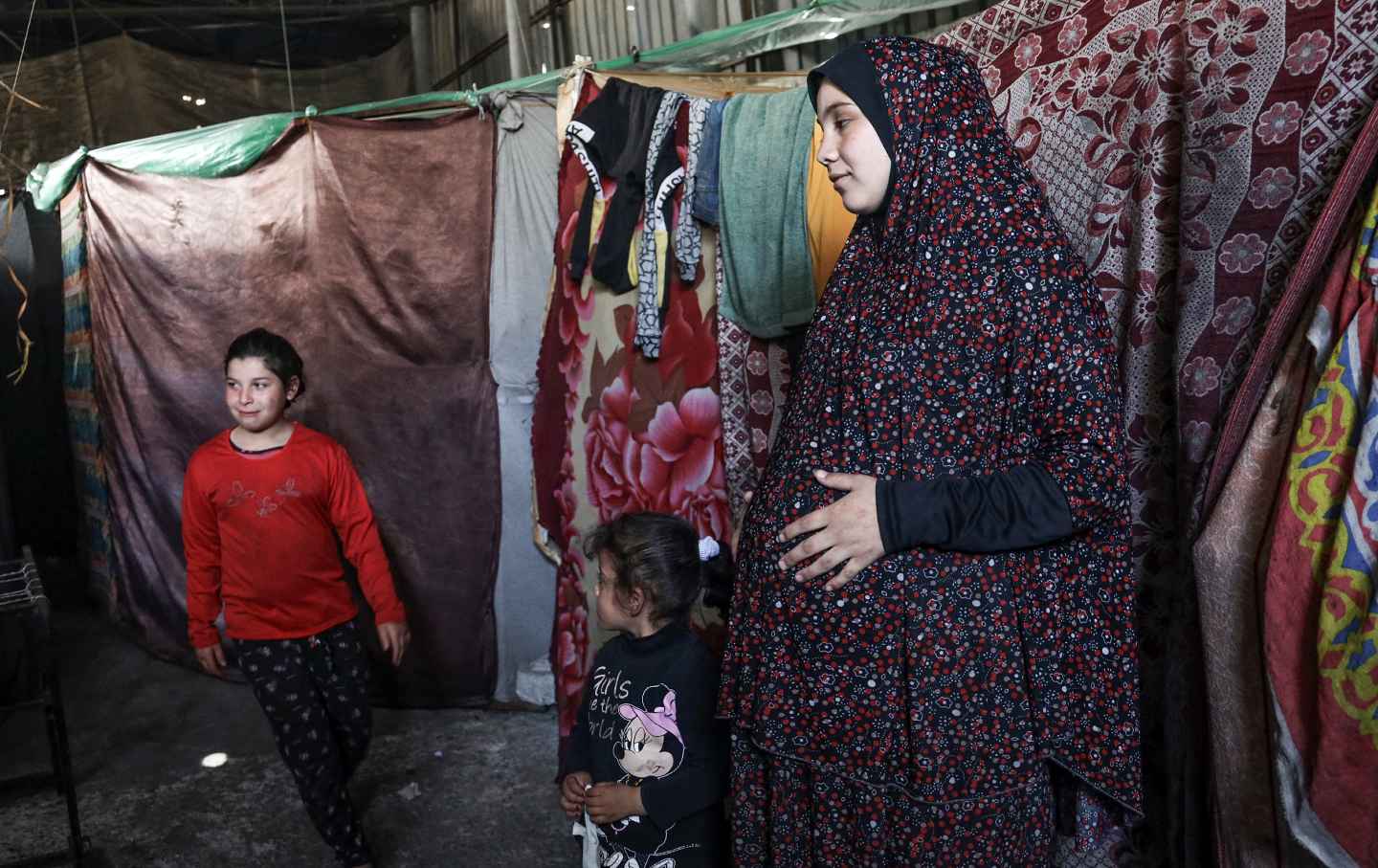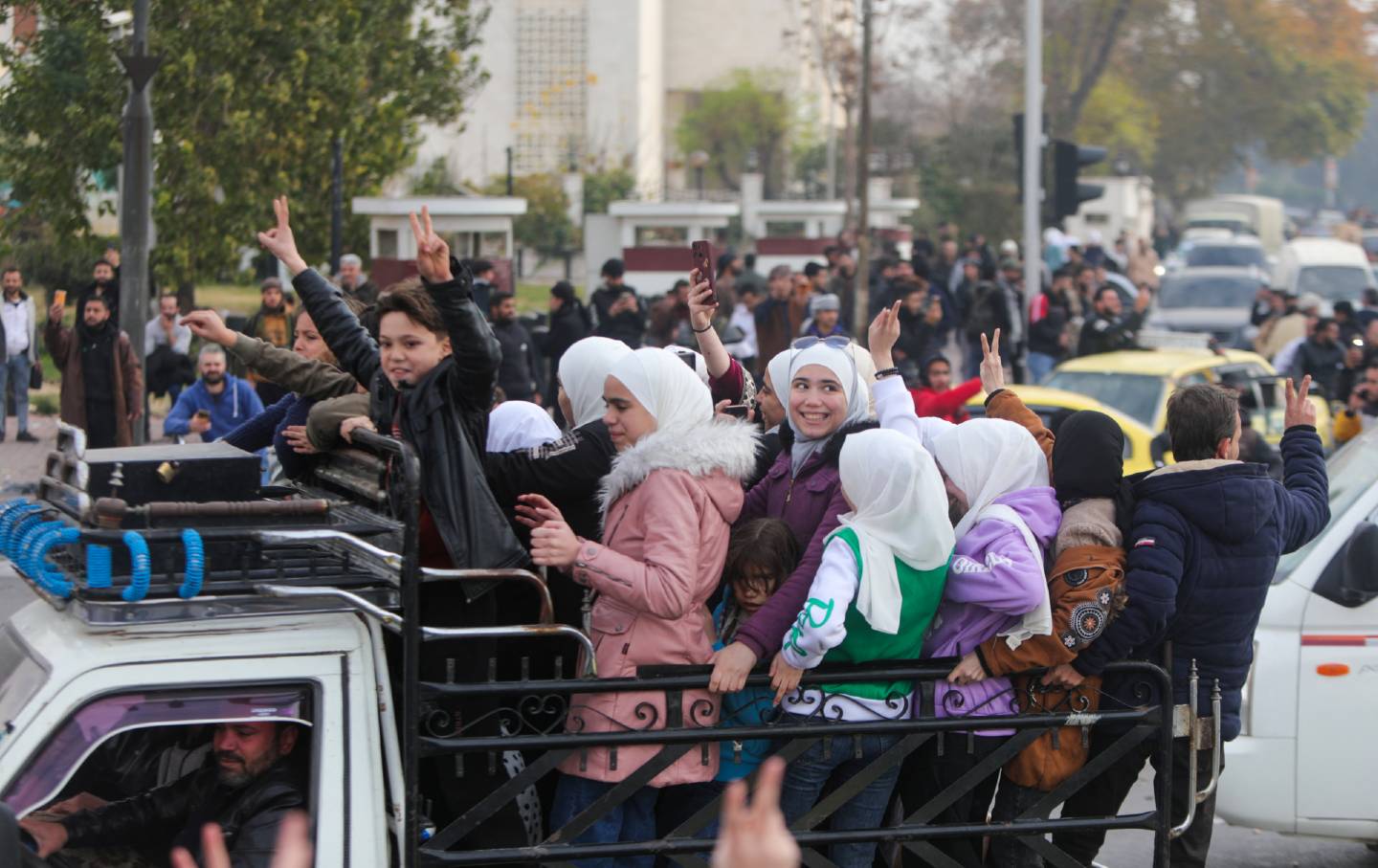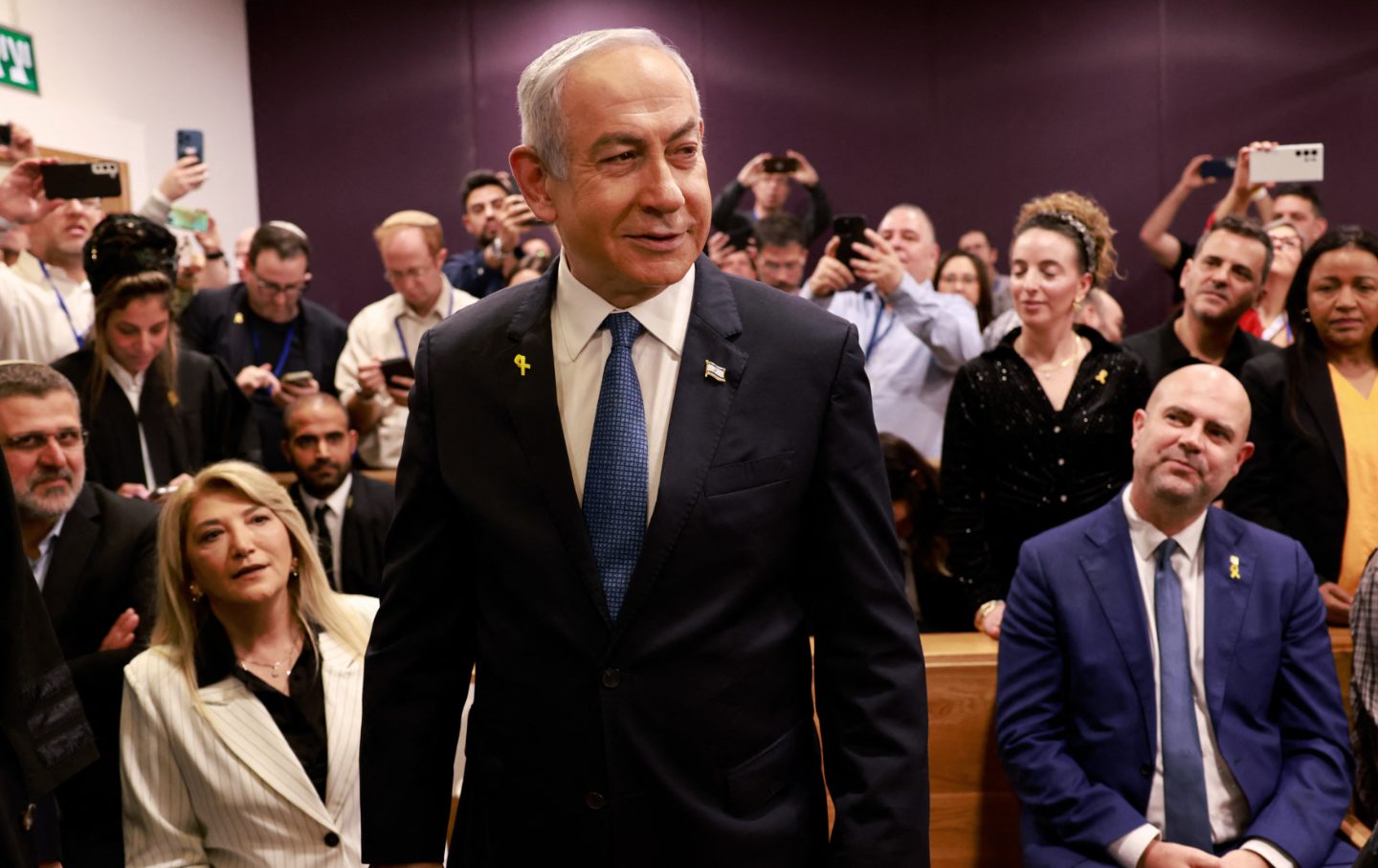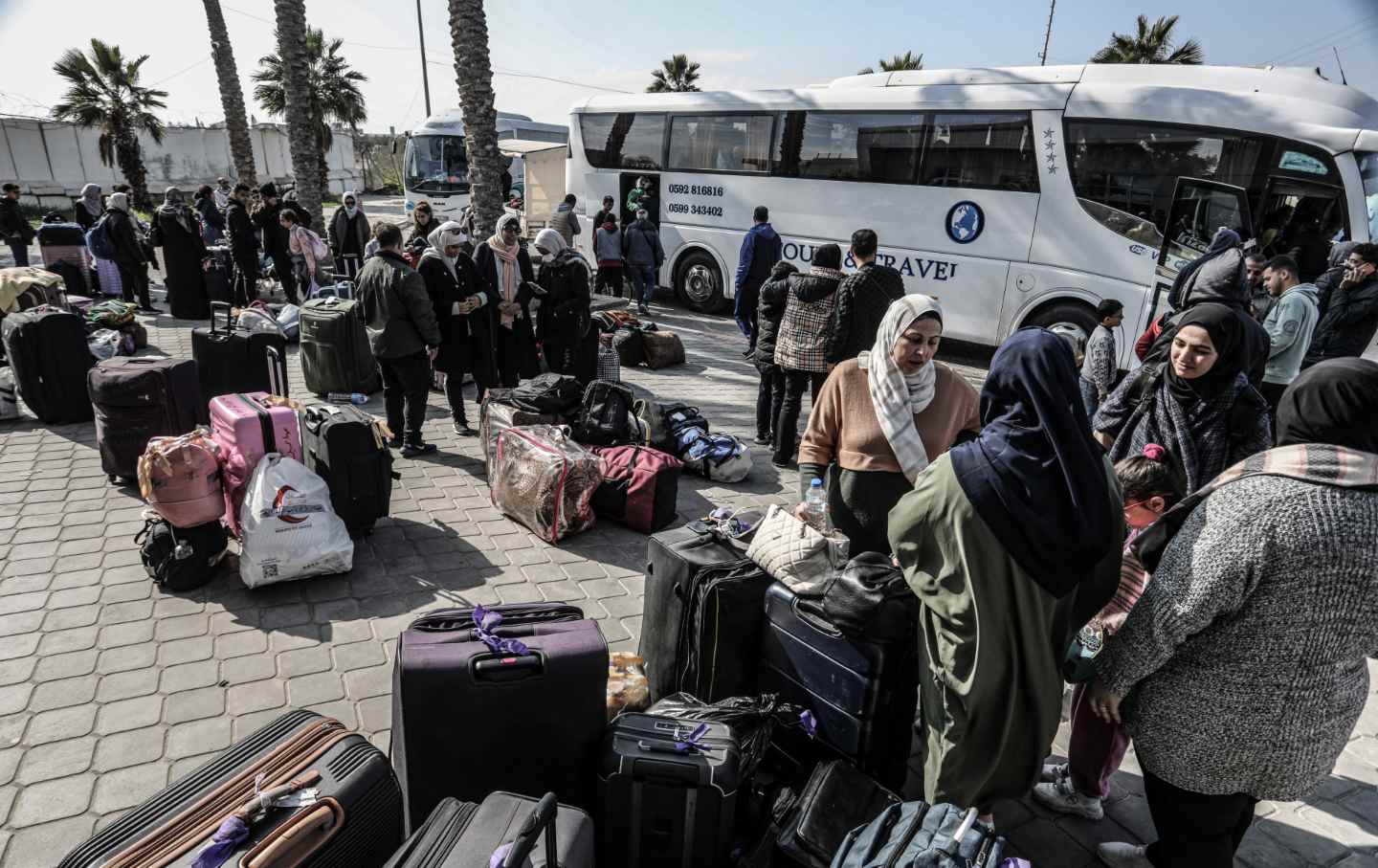The Hell of Having a Baby in Gaza
There is a reproductive justice nightmare taking place. Why aren’t American advocacy groups raising the alarm?

A pregnant Palestinian woman displaced from northern Gaza stands in a warehouse where she is taking shelter in Rafah, in the southern Gaza Strip, on February 29, 2024.
(AFP via Getty Images)Diana Siam, a 22-year-old from Gaza City, first recalls missing her period in November. She initially chalked it up to the toll of living under Israeli bombardment and having to find a new place to live over and over again. But she eventually had to come to terms with the fact that, even as she was struggling to care for her 16-month-old son, she was going to have another baby.
Siam is currently sheltering in a small, overcrowded house along with 20 others in Rafah, a city in southern Gaza swelling with over 1.5 million displaced Palestinians. She has no privacy, she says, nor the support of her mother, who lives in a different area that is entirely inaccessible due to sustained shelling. As a famine begins to set in, Siam and her husband survive solely on canned food; even if fresh produce is found, it is so expensive that the couple cannot afford to buy it. Siam says her baby now cries “most of the time” from hunger as her breast milk runs dry.
“I felt very angry because this is not a suitable time to be pregnant,” Siam says. “And I already have a baby. It will be so difficult to take care of two children in this situation.”
During her first pregnancy, Siam received the prenatal care that any pregnant person should expect. But now, Gaza’s healthcare system is on its last legs, making access to critical reproductive healthcare nearly impossible. Al-Helal Emirati Hospital is the sole hospital with maternity and obstetrics capabilities that remains operational in southern and central Gaza. (In northern Gaza, there are no functional hospitals at all.) Yet there are nearly 60,000 Palestinian women who are currently pregnant and suffering from malnourishment and dehydration, according to the Gaza health ministry. Meanwhile, Israel continues to arbitrarily deny entry to trucks full of critical supplies, including anesthetics, maternity kits, water filtration systems, and oxygen cylinders.
“It is the hardest situation I’ve faced,” Siam says. “Usually, I would have blood tests and see the baby on an ultrasound. But now everything in my life has become impossible.”
Women and children are bearing the brunt of the war’s consequences. Of the more than 30,000 Palestinians who have been killed since October 7, 13,000 are children and 9,000 are women. According to the United Nations Relief Works Agency for Palestine, an estimated 37 mothers are killed by Israel every single day.
And while the lasting impact of Israel’s genocidal campaign is difficult to comprehend, the reproductive healthcare catastrophe it is causing right now is all too real. The bombardment and blockade of Gaza have created a hellscape in which safe pregnancies, births, and parenthood have become entirely unfeasible. South Africa has argued in its case against Israel in the International Criminal Court that the prevention of births is itself a genocidal tactic.
The scale of the crisis demands a response from everyone in the world. But the unparalleled complicity of the Biden administration in that crisis means that American institutions—particularly reproductive justice and advocacy organizations—have a special obligation to speak out. The continued floundering of organizations that purport to care about reproductive rights—in the face of such a brutal affront against them—has the potential to leave an enduring stain on the legacy of the reproductive justice movement.
“If a mother dies, leaving her children, those children will not do well, both economically and healthwise,” says Dr. Deborah Harrington, a consultant obstetrician and subspecialist in fetal and maternal medicine. “This is in every study you look at. Not only is it a horrific trauma, but it will impact those children for the rest of their lives.”
Harrington traveled to Gaza with Medical Aid for Palestinians in late December and spent two weeks working at Al-Aqsa Hospital, where she was shocked to see the number of injured women and children filling its crowded wards. Hospitals are overwhelmed by the number of pregnant women who arrive seeking care, she says, and thousands more require medical attention but cannot access it.
The journey through areas surrounding hospitals is treacherous, and most women go into labor after nightfall, which is when the bombing intensifies. Even if they are brave enough to venture out of their shelters, women struggle to find fuel or transportation. There are either no ambulances to call for help or almost no way to call one, given Israel’s destruction of Gaza’s telecommunications infrastructure.
But babies do not wait, even in these circumstances. Out of time and with no other options, women are forced to give birth in the streets and in makeshift shelters. Some resort to giving birth inside cars to maintain some semblance of privacy and dignity, Harrington says. And things are not much better even if women get to a hospital. The overcrowding is nightmarish, and women overflow into the corridors, sometimes giving birth in beds already soaked with blood from previous deliveries.
“Hospitals were already bursting at the seams,” says Dr. Amber Alayyan, deputy operations manager for medical activities for Doctors Without Borders (Médecins Sans Frontières). “If they were bursting before, they are exploding right now.”
The difficulties continue after birth. Newborns are crammed into incubators, as need far outweighs supply. Access to baby formula is limited, and mothers who cannot secure clean water are mixing powder formula with soda and energy drinks, says CARE West Bank and Gaza Country Director Hiba Tibi. The risk of infection for both mothers and babies is soaring.
Given the unprecedented difficulties facing Palestinian women and children, it is undeniable that this is a reproductive justice crisis.
At the core of reproductive justice frameworks are the tenets of bodily autonomy, which include the right to have control over one’s body, agency over one’s future, and the choice to determine whether or not to have children. But without access to the resources necessary to fulfill even the minimal needs of life, including critical healthcare, there is no such thing as choice for women in Gaza. There is simply no concept of reproductive freedom.
“What is happening in Gaza right now is collective punishment,” says Dr. Roa Qato, an ob-gyn involved with the group Healthcare Workers for Palestine. “It is specifically affecting the vulnerable population of women, because our health has special needs.”
While the scale of the current crisis is unprecedented, it is important to recognize that the nearly two-decades-long Israeli blockade of the Gaza Strip set the stage. Since Israel imposed its siege in 2007, Gazans have had no real freedom of movement, which affects all facets of life, including health. Patients requiring specialized medical care unavailable in the Gaza Strip—including radiation for cancer—had to jump through administrative hoops to get permission from Israeli authorities to leave Gaza and receive treatment. Hundreds have died waiting for approval. And doctors and other medical professionals in Gaza hoping to leave temporarily in order to receive additional, postgraduate medical training were often denied.
In years prior, over half of pregnant women in the West Bank and Gaza were anemic—a rate that can only be increasing given the fact that, currently, over 90 percent of pregnant and breastfeeding women in Gaza are facing severe food poverty. The miscarriage rate among women has skyrocketed by 300 percent, according to CARE. Access to drugs commonly used in obstetrics practice to treat these issues—for example, progesterone, a hormone that helps women maintain pregnancies, and ergometrine, which is administered to stop excess bleeding during birth and abortions—has been unreliable in Gaza for years. It is now virtually impossible to obtain.
“If a woman hemorrhages during birth and she’s already anemic, she’s got no reserves,” says Harrington. “And if you don’t have the life-saving medications to be able to stop that hemorrhage, you cannot stop the bleeding.” She says that, because of this, more emergency hysterectomies, in which doctors must remove the uterus entirely to save the patient’s life, are being performed in the most dire of circumstances.
It is difficult to imagine how reproductive justice and medical organizations in the United States have been so passive in the context of these unimaginable horrors. The tenets these organizations claim to hold so dear—including access to basic reproductive healthcare and the resources necessary to have true bodily autonomy—are being systematically destroyed in Gaza, but their voices are whisper-quiet. Planned Parenthood, our so-called champion of the right to choose, has looked on after releasing a milquetoast statement. Even organizations that center intersectionality within reproductive justice frameworks, like Sistersong, only just called for a cease-fire after board members resigned in protest. The American College of Obstetricians and Gynecologists, which recently came under fire for giving political donations to candidates who restrict abortion access, has refused to address the concerns of multiple physicians who urged the organization to speak out.
“The organizations in this country need to be at the forefront of advocating for healthcare justice, in particular in this situation in Gaza,” says Qato. “We are not just bystanders. Our tax dollars are actively paying for and supporting this, rather than paying for universal healthcare or safe birthing centers here in the United States. That’s why this impacts each and every American.”
Popular
“swipe left below to view more authors”Swipe →By putting this issue on the docket, urging politicians to support an immediate and permanent cease-fire, and recognizing the fact that the struggle for reproductive rights in the United States is inextricably linked to the struggle of Palestinian women, perhaps these powerful organizations, which have access to massive resources, audiences, and the ability to lobby politicians for the sake of reproductive justice could enact real, material change. The simple truth is that, instead, they have forsaken Palestinian women and pregnant people.
“We should be ashamed that we can somehow tolerate women suffering in this way,” says Harrington. “A complete and sustained cease-fire is the only answer. Getting humanitarian aid, medical supplies, and teams in, and getting hospitals up and running again is just not possible without it.”
With a cease-fire in place, hundreds of aid trucks being blocked by Israeli restrictions could enter Gaza. The areas around hospitals performing maternity care would not be under the near-constant threat of bombing, shelling, and gunfire, like they are now, and teams of healthcare professionals could help to replenish the dwindling access to critical medical care.
But without any intervention into the current crisis, pregnant women in Gaza, like Diana Siam, must confront an uncertain future for themselves and their babies.
Siam wishes to know if her baby is a boy or a girl and prays that her child will be healthy. “I hope the situation will be changed soon and that the war will stop so that we can return to our daily life, to live as we wanted,” she says.
More from The Nation

Celebrations in Syria May Be Premature Celebrations in Syria May Be Premature
The speed of the Assad dictatorship's collapse stunned even the opposition. But the result is a power vacuum that Israel and Turkey have already moved to occupy.

The Fall of Syria Changes Everything The Fall of Syria Changes Everything
Retired diplomat Chas Freeman and writer Pascal Lottaz discuss what happens now that Damascus is in the hands of Hayat Tahrir al-Sham.

Netanyahu Must Be Brought to Justice. But We Can’t Stop There. Netanyahu Must Be Brought to Justice. But We Can’t Stop There.
This genocide is a massive criminal undertaking, and we must hold as many of its perpetrators accountable as we can.

My Brother, Chef Mahmoud Almadhoun, Died Because He Fed Gaza’s Starving Citizens My Brother, Chef Mahmoud Almadhoun, Died Because He Fed Gaza’s Starving Citizens
His killing by Israel sent a chilling message that no one is safe, including humanitarians who stand in the way of Gaza’s erasure.

The Underground Network Helping Gazan Refugees Survive in Egypt The Underground Network Helping Gazan Refugees Survive in Egypt
A patchwork of volunteer-run mutual aid organizations has sprung up to tackle the severe problems facing people fleeing genocide.

The Dangers of Trump’s Foreign Policy The Dangers of Trump’s Foreign Policy
Strategic incoherence and factionalism reign.


